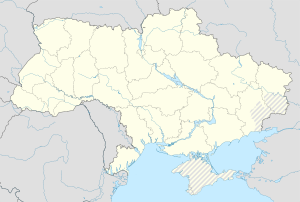| Zhovkva castle | |
|---|---|
| 30 km from Lviv, Western Ukraine | |
 The front side of the castle | |
| Coordinates | 50°3′16″N 23°58′8″E / 50.05444°N 23.96889°E |
| Site information | |
| Open to the public | Yes |
| Site history | |
| Built | 1594-1606 |
| Materials | Stones and bricks |
The Zhovka castle occupies the principal square of the town of Zhovkva in Ukraine. It was founded by Stanislaw Zolkiewski as his fortified residence. Construction began in 1594 and was mostly completed in 1606.
The castle had a typically Serlian entrance arch and was encircled by moats (up to 17 meters in width). One wing of the building accommodated the arsenal and stables; another was immediately contiguous to the city wall. In 1606, a garden was laid out next to the hetman's residence. It contained a menagerie with wisents, deers, and chamois. The palatine chapel was consecrated in 1640.
The golden age of the Zolkiew Castle was the late 17th century when it passed through inheritance to Jakub Sobieski and then to his son John III, a native of Zhovkva. It was there that the king celebrated his victory under the walls of Vienna. In the 18th century the castle's facade was decorated with the statues of its owners from the Zolkiewski, Danilewicz, Sobieski, and Radziwill families.
After the partition of Poland the castle fell into disuse and was auctioned off. During the 19th century the chapel and some other structures were dismantled or rebuilt to accommodate a local school. The castle sustained further damage during the First World War. Some restoration was undertaken just before the Second World War, but much more was required following the end of hostilities.
References
edit- Лильо І. М., Лильо-Откович З. М. Прогулянка Львовом. Путівник — К.: Балтія Друк, 2005. — 224 с.: іл.
- Памятники градостроительства и архитектуры Украинской ССР. Киев: Будивельник, 1983—1986. Том 3, с. 152.
Castle in Zhovkva - an architectural monument of the Renaissance in Zhovkva, Lviv region (Ukraine). Located on the 2 Vicheva square. Included to the State Register of Cultural Heritage of Ukraine under № 1928 (385 / 0).
Castle was built by Stanislav Zholkevsky in 1594-1606 as defensive structure in the Renaissance style. Castle withstand the sieges, although several times the Cossacks took him. At the end of XVII century Zhovkva castle was the favorite residence of Polish King Jan III Sobieski. Thanking to Jan III Sobieski castle had the greatest period of prosperity. It's modern look Zhovkva castle acquired as a result of many rearrangements and neglect during the XIX-XX centuries. Now castle is under reconstruction, but courtyard and a museum are opened to visitors.
The castle was built of bricks and stones. Quadrangularly planed with towers at the corners, surrounded by a moat with water, not only outside but also from the side of the city, the castle was well protected from enemy attacks. However, modern appearance does not match ancient one - columns, arches, exquisite sculptures, ditch that reached in width to 17 meters, are "missing" and the castle is просів у землю land by 6-7 meters.
Axis north-east building entrance gate located on Overgate tower. Carved white stone gate decorated with a portal style manyeryzmu. Northern, eastern and southern corner tower of the castle - irregular pentagonal shape, three-tier, covered pavilion roofs. West Tower - in the ruined. Windows and buildings south-east tower are carved frame with white stone. At the castle galleries and Overgate towers preserved loophole, which cuts most laid.
Southwest castle building (palace) - representational. He - two-storey with basement. In planning this building used dvohryadnu system suite. It housed the private quarters of the owner, treasury, offices and state rooms for official receptions. They, on the second floor, were the grand staircase. Also the owners quarters adjacent chapel, built in 1640.
Domestically southwest building of the castle were statues of the four owners Zhovkva: Zholkevsky, Davidovich, Sobieski, Radziwill. It was also built public gallery of the Two-storeyed arcades, the first tier uses convoy Tuscany warrant, in the second - Ionic.
In the court preserved house where the owners lived in the city. The front wing served as an arsenal, barn and housing for soldiers and servants. When stables was coach yard, while Arsenal - forge. The Eastern wing was housing for the many guests of the castle. In the west were the castle kitchen, bakery, pantry. Before this wing was oak water supply from which flowed in riverbed spring water.
Just circle the castle river pig.
